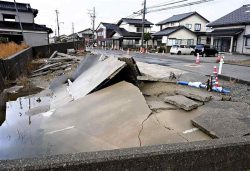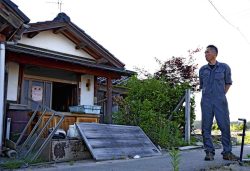Noto Quake — A Closer Look / Lack of Information, Damaged Roads Hampered Quake Response; Insufficient Preparations Questioned

A blocked road is seen in Wajima, Ishikawa Prefecture, on Jan. 2, one day after the Noto Peninsula Earthquake.
17:18 JST, February 6, 2024
More than a month has passed since the deadly Noto Peninsula Earthquake on Jan. 1. This is the fourth installment of a series examining issues that have emerged in the disaster-stricken areas.
***
Flying over the Noto Peninsula, the 11 crew members of a Maritime Self-Defense Force P-1 patrol aircraft saw a strange sight. Urban areas that should have been visible directly below were shrouded in darkness.
“There aren’t any lights. Is there a blackout?” a 29-year-old lieutenant junior grade muttered to himself.
The nose of the plane was equipped with a thermal imaging camera for nighttime use. When the magnification was increased, collapsed buildings appeared on the screen, as well as dirt and sand blocking roads.
The crew members could see a red sky in the city of Wajima, Ishikawa Prefecture, even from the opposite side of a mountain. During their six-hour reconnaissance operation, they twice confirmed fires in the city.
“There could be substantial damage,” said the 44-year-old captain of the plane, an MSDF lieutenant commander, while staring out the window.
The Noto Peninsula Earthquake, which measured a maximum of 7 on the Japanese seismic intensity scale, occurred just after 4 p.m. as the sun was setting on Jan. 1. In 2007 and 2023, the Noto region had been hit by upper-6 level earthquakes, resulting in one fatality each.
Immediately after the 2024 earthquake, there was hope within the central government that the damage might be slight. However, reports came in one after another, including the fact that the situation could not be fully assessed due to the distorted roads.
At around 5 p.m. on Jan. 1, Prime Minister Fumio Kishida spoke by phone with Shoji Nishida, a Liberal Democratic Party member who was elected to the House of Representatives from Ishikawa Prefecture.
“The tremors are completely different from last year’s earthquake. Please help Noto,” Nishida implored the prime minister.
At 5:30 p.m., the government temporarily set up a headquarters to deal with the damage, headed by Yoshifumi Matsumura, state minister for disasters. About five hours later, Kishida upgraded it to an emergency disaster measures headquarters headed by himself, determined to take all possible measures even if they ultimately proved unnecessary.
That night, Kishida’s angry voice was heard in the Prime Minister’s Office in Nagatacho, Tokyo.
“Send in Self-Defense Forces personnel and police tonight, no matter what,” Kishida said.
When a disaster strikes, the SDF conduct search and rescue operations based on information provided by local governments. This time, however, this approach did not work because transportation and communication networks were cut off.
It was most difficult to assess the damage in Wajima, which had the largest number of cut-off communities. Of about 280 Wajima city employees, only about 50 were able to get to their office on Jan. 1.
The only information available was that provided by SDF personnel.
SDF personnel rushed around the city, climbing over collapsed earth and sand. The number of isolated communities was almost fully determined by the morning of Jan. 4. It was nearly 72 hours after the disaster, a point at which the survival rate is said to drop sharply.
The lack of preparedness for an emergency is also being questioned. The regional disaster prevention plan drawn up by the Ishikawa prefectural government estimated that in the event of an “earthquake off the northern coast of the Noto Peninsula,” damage would be “very localized and of low severity.”
The city government of Wajima, which has a population of about 23,000, had stockpiled emergency rations for only a few thousand people. These supplies ran out on the first day of the disaster.
The prefectural government was in the process of reviewing its damage estimates in light of the numerous earthquakes that have occurred over the past several years. Ishikawa Gov. Hiroshi Hase has said the discrepancies between the estimates and the actual damage had “no impact at all” on the initial response, but it cannot be denied that the response to the earthquake was delayed.
There are many areas in Japan where the transportation network is too fragile for SDF personnel to be adequately deployed, and supplies have not been stockpiled sufficiently. As depopulation and the greying of society continue, the earthquake-prone nation of Japan could face a similar situation again.
“We’re facing challenges not seen in past disasters. It’s essential to examine the current situation at some point and draw lessons from it,” a senior central government official said.
Nobuo Fukuwa, a professor emeritus at Nagoya University, said: “In the event of a Nankai Trough earthquake, SDF personnel, police and firefighters may not be able to reach the tips of the Kii Peninsula or Izu Peninsula by land.”
In the worst case scenario, about 230,000 people are expected to die or go missing in such a massive earthquake, which could cause tsunami in the peninsula regions, start fires and destroy gas, water and other infrastructure there.
“Compared to the gravity of the disaster, there will be insufficient resources for rescue, including the SDF,” Fukuwa warned. “We need to remind ourselves once again to protect our own lives through such steps as making our homes earthquake-resistant and stockpiling food and portable toilets.”
The SDF continues to work in the quake-hit region, with about 4,000 personnel there as of Sunday. It will review its activities after all its operations are completed, in the belief that lessons from the Noto quake can be applied to a future Nankai Trough earthquake.
"Society" POPULAR ARTICLE
-

M4.9 Earthquake Hits Tokyo, Neighboring Prefectures
-

M7.5 Earthquake Hits Northern Japan; Tsunami Waves Observed in Hokkaido, Aomori and Iwate Prefectures
-

Tsukiji Market Urges Tourists to Avoid Visiting in Year-End
-

Israeli Tourists Refused Accommodation at Hotel in Japan’s Nagano Pref., Prompting Protest by Israeli Embassy and Probe by Prefecture
-

M5.7 Earthquake Hits Japan’s Kumamoto Pref., Measuring Upper 5 Intensity, No Tsunami Expected
JN ACCESS RANKING
-

Keidanren Chairman Yoshinobu Tsutsui Visits Kashiwazaki-Kariwa Nuclear Power Plant; Inspects New Emergency Safety System
-

Imports of Rare Earths from China Facing Delays, May Be Caused by Deterioration of Japan-China Relations
-

University of Tokyo Professor Discusses Japanese Economic Security in Interview Ahead of Forum
-

Japan Pulls out of Vietnam Nuclear Project, Complicating Hanoi’s Power Plans
-

Govt Aims to Expand NISA Program Lineup, Abolish Age Restriction























